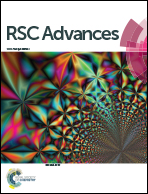Influence of denticity and combined soft–hard strategy on the interaction of picolinic-type ligands with NpO2+†
Abstract
The interaction of neptunyl ions (NpO2+) with three picolinic type ligands (L), including the deprotonated picolinic acid anion (PA−), the deprotonated dipicolinic acid anion (DPA2−) and the 1,10-phenanthroline-2,9-dicarboxylic acid anion (PADA2−), was investigated by using a density functional theory method with various stoichiometric ratios of Np : L = 1 : 1, 1 : 2, and 1 : 3. The coordination modes, the influence of the denticity of the ligands, and the stoichiometry of the complexes were evaluated in terms of geometry, electronic structure, and thermodynamics. The calculations show that the coordination of NpO2+ to tetradentate ligands is more stable than that to tridentate and bidentate ones, and the coordination ability of the three deprotonated ligands follows the order: PADA2− > DPA2− > PA−. Quantum theory of atoms-in-molecules (QTAIM) analysis, charge decomposition analysis (CDA) and natural atomic orbital (NAO) analysis were used to understand the bonding nature and electronic properties of the complexes, and the metal–ligand dative bond was identified to be mainly ionic. In view of the favorable coordination modes and the distinct ability of the ligands in binding to neptunyl, we conclude that the denticity of the ligands and the combined hard–soft donor strategy work cooperatively in the coordination of NpO2+ with ligands. This work is expected to contribute to the rational design of new types of ligand with enhanced ability to extract neptunyl.



 Please wait while we load your content...
Please wait while we load your content...